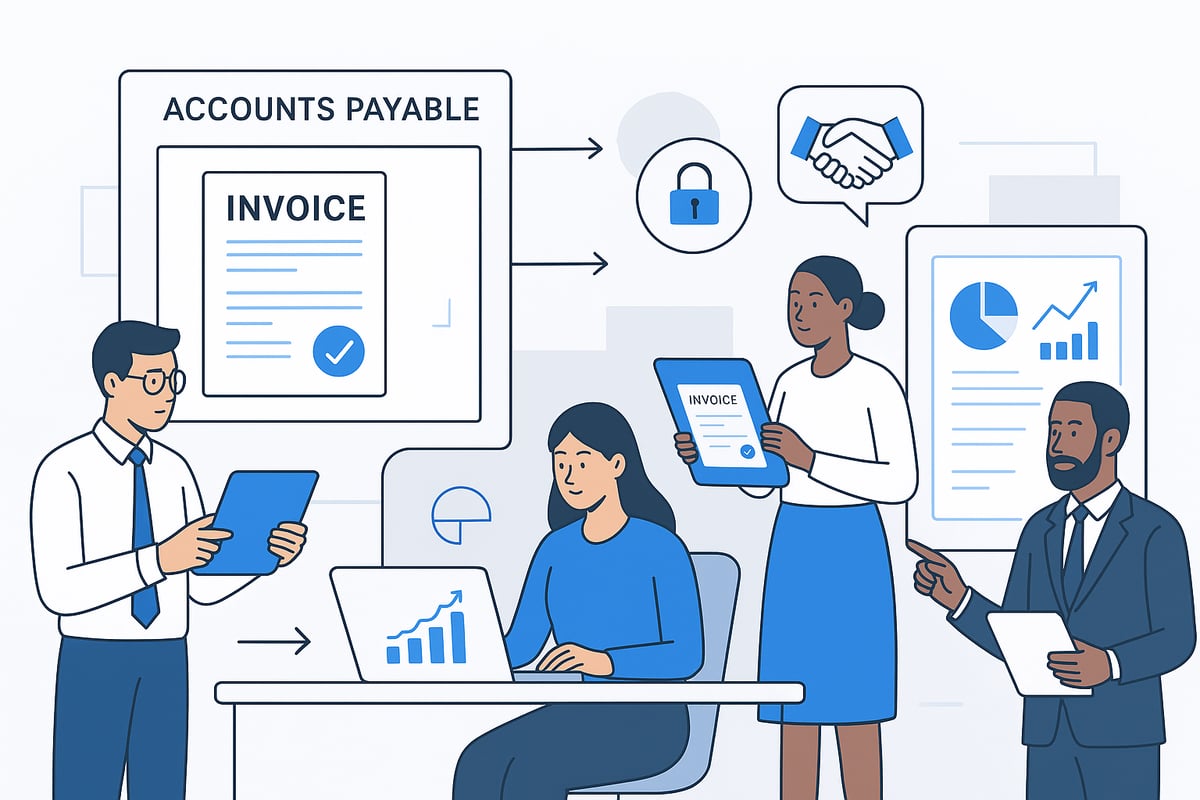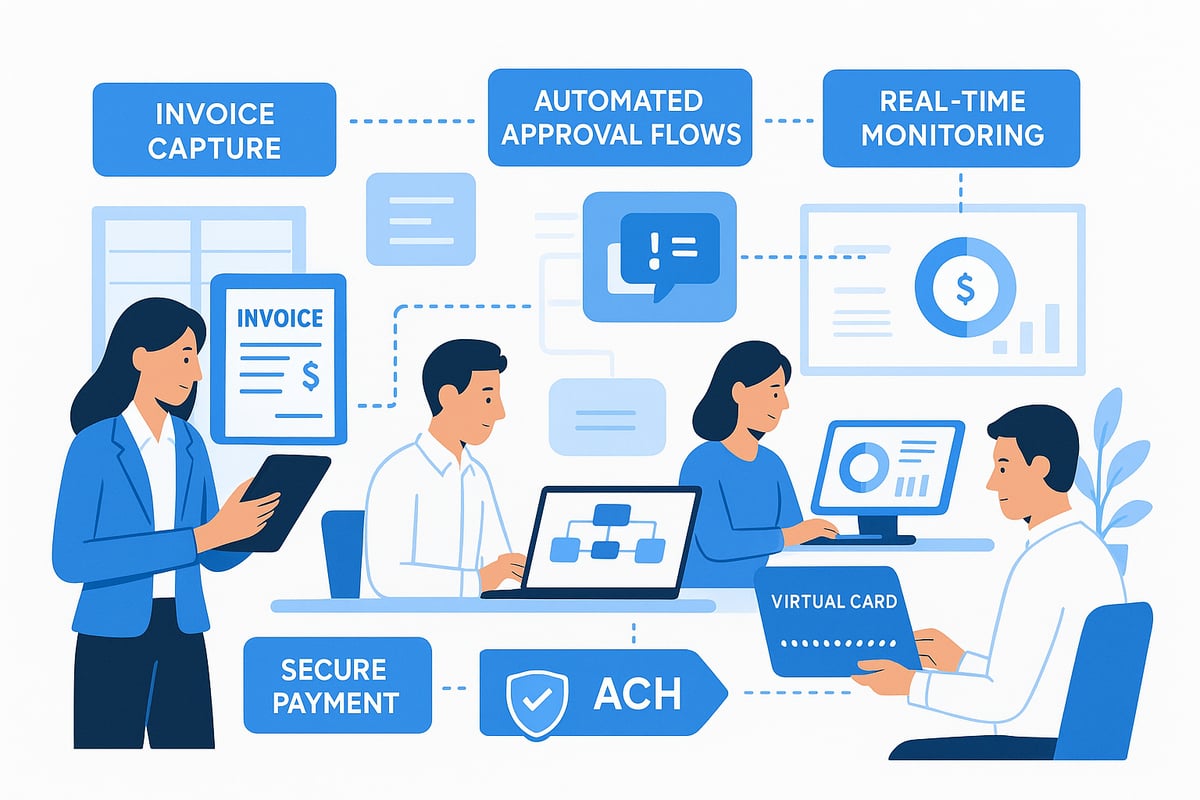Accounts Payable Guide: Best Practices for 2025
In 2025, managing accounts payable efficiently is essential for business resilience and profitability. As organizations face growing risks from fraud and inefficiency, the opportunities for automation and streamlined processes become clear.
This comprehensive guide reveals how mastering accounts payable can unlock cost savings, strengthen vendor relationships, and turn AP from a cost center into a true strategic asset.
Explore the latest best practices, actionable strategies, and technology trends designed to secure accuracy, compliance, and scalability. Apply these proven methods to future-proof your accounts payable and drive lasting success.
Understanding Accounts Payable: Core Concepts for 2025
Accounts payable is a cornerstone of financial health for every business. In 2025, understanding its core concepts is vital for managing cash flow, sustaining supplier trust, and supporting business growth. This section breaks down what accounts payable is, how the workflow operates, the key metrics you should track, and the most pressing challenges to watch for.

Definition and Role of Accounts Payable
Accounts payable represents the short-term obligations a company owes to its suppliers for goods or services received on credit. It appears as a current liability on the balance sheet and directly affects working capital. For instance, if a manufacturer buys raw materials on credit, the amount owed is recorded as accounts payable.
It is important to distinguish accounts payable from accounts receivable. While accounts payable reflects what a business owes, accounts receivable shows what others owe to the business. For example, a utility bill due next month is part of accounts payable, whereas a customer invoice awaiting payment falls under accounts receivable.
The accounts payable department handles invoice processing, payment scheduling, and supplier communications. Common accounts payable expenses include raw materials, outsourced services, and utilities. By managing accounts payable effectively, businesses can maintain strong supplier relationships and uninterrupted operations. To learn more about how accounts payable influences liquidity, visit this quick ratio and liquidity guide.
The Accounts Payable Workflow: Step-by-Step
The accounts payable process follows a structured workflow to ensure accuracy and prevent errors. It typically begins with a purchase order, followed by receiving the supplier's invoice. Next, the invoice undergoes approval, often requiring verification against the purchase order and delivery receipt—a process known as 3-way matching.
Once approved, payment authorization is granted, and the actual payment is executed. Each stage in this workflow is critical for catching discrepancies and avoiding fraud. Companies may handle these steps manually, using paper documents and physical signatures, or automate them with digital solutions for greater speed and consistency.
For example, when ordering office supplies, an employee generates a purchase order, receives the goods and invoice, and the accounts payable team verifies all documents before processing payment. Automation reduces manual errors and accelerates the workflow.
Key AP Metrics and Performance Indicators
Tracking the right metrics is essential for optimizing accounts payable. Two key indicators are Days Payable Outstanding (DPO) and the Accounts Payable Turnover Ratio. DPO measures how long a company takes to pay its suppliers, while the turnover ratio shows how frequently payables are settled during a period.
| Metric | Definition | 2025 Benchmark (Sample) |
|---|---|---|
| Days Payable Outstanding | Average days to pay suppliers | 35-45 days |
| AP Turnover Ratio | Number of times payables are paid in a year | 8-12 times |
A higher DPO can improve cash flow but may strain supplier relationships. Conversely, a lower DPO signals prompt payments, which can foster trust but reduce available cash for other uses. Monitoring these metrics helps shape accounts payable strategies that balance liquidity and supplier satisfaction.
Common Challenges in Accounts Payable
Managing accounts payable comes with several risks and obstacles. Common challenges include:
- Late payments, resulting in penalties or damaged vendor trust
- Duplicate invoices, leading to overpayments
- Fraud schemes, such as false invoices or kickbacks
- Compliance issues, especially with tax regulations and internal policies
Poor accounts payable management can disrupt supply chains, increase costs, and expose a business to fraud. For instance, an organization lacking robust controls may fall victim to a false invoice scheme, causing financial loss. According to MineralTree, 82 percent of organizations have experienced fraud due to weak internal controls. Implementing strong processes and regular audits is essential for safeguarding the accounts payable function.
The Modern Accounts Payable Process: Best Practices for 2025
Modernizing your accounts payable process is essential for maintaining accuracy, efficiency, and resilience. Let’s break down the five critical steps that define best practices for 2025, ensuring your AP function is ready for the challenges ahead.

Step 1: Digital Invoice Capture and Data Entry
Digital invoice capture transforms how accounts payable teams handle incoming documents. By shifting to electronic invoice submission, businesses minimize manual entry, reducing errors and speeding up processing times. Automated tools, such as OCR (optical character recognition), digitize paper invoices and extract data with high accuracy.
Key benefits include:
- Fewer manual errors
- Faster invoice processing
- Improved data accuracy
E-invoicing adoption is on the rise, making this step a cornerstone of modern AP. For a deeper dive into strategies, check out 17 best practices to optimize your accounts payable in 2025. Streamlining this process sets the stage for efficiency in every downstream AP task.
Step 2: Streamlined Invoice Approval Workflow
A robust invoice approval workflow is vital to accounts payable efficiency. Automated approval routing assigns invoices to the right approvers based on value, department, or project. This approach ensures segregation of duties, a key control against fraud.
Features of an optimized workflow include:
- Automated notifications for pending approvals
- Real-time tracking of invoice status
- Escalation rules to prevent delays
By removing bottlenecks, automated workflows help teams avoid missed payment deadlines and maintain strong supplier relationships. Accounts payable departments benefit from reduced cycle times and improved accountability.
Step 3: Payment Authorization and Scheduling
Payment authorization is a crucial safeguard in the accounts payable process. Dual authorization ensures that no single individual can release payments without oversight. Payment controls, such as approval limits and secure access, further protect company funds.
Best practices for payment scheduling include:
- Selecting optimal payment dates to maximize cash flow
- Taking advantage of early payment discounts
- Aligning payments with supplier terms
For example, timing payments under ‘2/10 net 30’ terms can unlock valuable discounts. Security remains central, with accounts payable teams using secure portals to authorize and schedule payments.
Step 4: Secure Payment Execution and Reconciliation
Executing payments securely is a top priority for accounts payable professionals. Today, options like ACH transfers, checks, virtual cards, and wire transfers offer flexibility. Virtual cards, in particular, provide enhanced security and the potential for rebates.
Key considerations for payment execution:
- Choosing the right payment method for each vendor
- Using secure payment platforms to prevent fraud
- Reconciling payments promptly for accurate reporting
Regular reconciliation ensures the accounts payable ledger matches bank records, supporting compliance and audit readiness.
Step 5: Continuous Monitoring and Exception Handling
Continuous monitoring is essential for a resilient accounts payable process. Real-time dashboards allow teams to track transactions and spot anomalies quickly. Automated alerts flag duplicate invoices, failed payments, or discrepancies.
Exception handling includes:
- Investigating disputed invoices
- Resolving failed transactions promptly
- Documenting remediation steps
Timely resolution of exceptions maintains trust with suppliers and upholds the integrity of the accounts payable process. Ongoing monitoring helps organizations adapt quickly to new risks and opportunities.
Leveraging Automation and Technology in Accounts Payable
In 2025, automation stands at the forefront of accounts payable transformation. Businesses are turning to technology to manage increasing invoice volumes, evolving compliance needs, and the demand for real-time insights. Leveraging automation in accounts payable not only streamlines operations but also creates a foundation for scalability and resilience.

The Rise of AP Automation: 2025 Trends
The shift from manual to automated accounts payable processes is accelerating. In 2025, organizations are adopting solutions that automate invoice capture, approval workflows, and payment execution. These automation features reduce human error, speed up processing, and strengthen controls.
AI-powered tools are now able to detect fraud, flag duplicates, and optimize workflows for maximum efficiency. According to industry reports, over 70 percent of companies plan to increase their investment in AP automation this year. For a deeper dive into key automation practices, see these Top 10 Accounts Payable Best Practices for 2025.
Choosing the Right AP Software and Integrations
Selecting the best software is crucial for accounts payable success. Look for platforms that integrate seamlessly with your existing ERP, offer a user-friendly interface, and include robust compliance tools. Features such as automated three-way matching, customizable approval hierarchies, and real-time analytics are now standard.
Comparison Table: Key Features of Leading AP Software
| Feature | Importance | Example Solutions |
|---|---|---|
| ERP Integration | Essential | Oracle NetSuite, Sage |
| Compliance Tools | High | SAP Concur, Tipalti |
| User Experience | Critical | Stampli, MineralTree |
Vendor support and scalability should also factor into your decision, ensuring long-term success in accounts payable automation.
Benefits of Automation: Efficiency, Accuracy, and Savings
Automating accounts payable delivers measurable gains. Manual processes are time-consuming and prone to error, whereas automation reduces invoice processing time from days to hours. This shift results in faster approvals, lower labor costs, and fewer payment mistakes.
Automation also improves accuracy, enhances security, and helps prevent fraud. Companies see positive impacts on Days Payable Outstanding and are better positioned to capture early payment discounts. The result is a more agile, efficient accounts payable department that supports overall business goals.
Overcoming Implementation Challenges
Transitioning to automated accounts payable systems is not without hurdles. Common barriers include resistance to change, the complexity of integrating with legacy systems, and upfront investment costs.
To ease adoption, organizations should secure stakeholder buy-in, roll out automation in phases, and invest in thorough training. Pilot programs can demonstrate the return on investment, while ongoing support ensures sustained success. Change management is essential for a smooth transition to automated accounts payable processes.
Future-Proofing AP: AI, Analytics, and Beyond
The future of accounts payable lies in leveraging AI-driven analytics, predictive cash flow modeling, and even blockchain. AI can spot anomalies, forecast payment cycles, and optimize working capital strategies. Analytics tools provide real-time visibility, empowering finance teams to make informed decisions.
As regulatory requirements and technology evolve, staying adaptive will be key. Investing in flexible, future-ready accounts payable solutions ensures your business remains compliant, efficient, and competitive in 2025 and beyond.
Strengthening Internal Controls, Compliance, and Fraud Prevention
Effective accounts payable management in 2025 demands robust internal controls, strict compliance, and proactive fraud prevention. Organizations that prioritize these areas not only protect their financial assets, but also build trust with stakeholders and suppliers.

Essential Internal Controls for AP Security
Strong internal controls form the backbone of secure accounts payable operations. Key controls include segregation of duties, where different staff handle invoice approval, payment authorization, and reconciliation. This reduces the risk of errors or fraud.
Audit trails are essential, tracking every action in the accounts payable process. Role-based access ensures only authorized personnel can initiate or approve payments. Regular reviews and updates of controls keep the system resilient against emerging risks.
For a deeper dive into best practices, see AP Accounting Best Practices: Top 10 Tips to Optimize in 2025.
Ensuring Regulatory Compliance in AP
Maintaining compliance in accounts payable is critical to avoid penalties and reputational damage. Key regulations include SOX, local tax laws, and anti-fraud statutes. Automated compliance checks can validate invoice legitimacy and vendor details before payment.
Detailed documentation and audit readiness are non-negotiable. Keeping organized digital records for each transaction streamlines both routine reviews and formal audits. Compliance should be a continuous process, not a one-time activity.
Fraud Risks and Prevention Strategies
Accounts payable is a prime target for fraud schemes like false invoices, duplicate payments, and kickbacks. To combat these risks, organizations should:
- Implement vendor verification procedures
- Use AI-driven tools to flag suspicious transactions
- Conduct regular internal and external audits
- Enforce whistleblower policies
Proactive fraud prevention keeps financial losses and reputational harm at bay.
AP Audits: Preparing and Succeeding
Routine audits validate the accuracy and integrity of accounts payable records. The audit process examines documentation, approval workflows, and payment histories.
To prepare, maintain comprehensive records for every invoice and payment. Use checklists to ensure all compliance requirements are met. Respond to auditor requests with transparency and promptness. Audits are not just a control, but an opportunity to strengthen operations further.
Building a Culture of Accountability and Ethics
A culture of accountability is essential for sustainable accounts payable performance. Staff should receive regular training on ethical guidelines, conflict of interest policies, and best practices.
Encourage disclosure of supplier relationships and reinforce the importance of transparency. Ongoing education and ethical leadership set the tone for the department. When everyone is engaged and informed, the risk of misconduct decreases, and the organization’s reputation is protected.
Optimizing Cash Flow and Supplier Relationships Through AP
Effectively managing accounts payable is vital for strengthening your organization’s liquidity and supporting sustainable supplier partnerships. By refining your AP processes, you can unlock new opportunities for growth, minimize risk, and set your business apart in today’s competitive landscape.
The Strategic Role of AP in Cash Flow Management
Strategic timing of accounts payable directly influences working capital and liquidity. By carefully scheduling payments, businesses can optimize their available cash while maintaining reliability with suppliers. For example, extending payment terms can temporarily boost cash reserves, but it is important to balance this with the need for supplier satisfaction.
Organizations that align their accounts payable cycles with cash inflows can better withstand economic uncertainty. According to MineralTree, AP can be a source of cash if managed properly. To learn more about actionable strategies, see 10 Accounts Payable Best Practices to Maximize Liquidity in 2025.
Harnessing Early Payment Discounts and Dynamic Discounting
Early payment discounts, such as “2/10 net 30,” reward prompt settlement of invoices with cost savings, while dynamic discounting offers flexible terms based on payment timing. By leveraging automation, accounts payable teams can consistently capture these opportunities, improving margins and supplier goodwill.
For instance, paying a $10,000 invoice within 10 days at a 2 percent discount saves $200. Over time, these savings add up. Automated systems help identify and prioritize invoices eligible for discounts, ensuring your business does not miss out on affordable liquidity.
Vendor Management and Collaboration
Strong supplier relationships depend on timely and accurate accounts payable processes. Delays or errors can damage reputations and disrupt business continuity. Effective vendor onboarding, transparent communication, and proactive resolution of disputes are crucial for building trust.
Many organizations now implement self-service supplier portals, enabling vendors to track payment status and submit queries directly. This approach not only reduces administrative burden but also enhances collaboration and mutual understanding.
AP’s Role in Supply Chain Resilience
Efficient accounts payable is essential for maintaining supply chain continuity, especially during disruptions. Late or missed payments can jeopardize access to critical goods and services, affecting the entire operation. AP teams that prioritize prompt, accurate payments help suppliers remain stable and responsive.
During supply chain crises, fast-tracking certain payments or supporting supplier sustainability initiatives demonstrates partnership and commitment. AP can also contribute to broader ESG (Environmental, Social, and Governance) goals by supporting diverse and responsible sourcing.
Measuring and Improving AP Performance
Continuous improvement begins with tracking the right accounts payable key performance indicators (KPIs). Metrics such as Days Payable Outstanding (DPO), cost per invoice, and error rates provide insights into efficiency and effectiveness.
| KPI | What it Measures | 2025 Benchmark |
|---|---|---|
| DPO | Payment timing | 45-55 days |
| Cost per Invoice | Processing cost | $2-$5 |
| Error Rate | Invoice/payment accuracy | <1% |
Benchmarking your accounts payable performance against industry standards can reveal areas for optimization. For deeper insight into how AP management affects financial health, see Working with operating margin. Regularly reviewing processes ensures your AP function drives both cost control and supplier satisfaction.
Building and Leading a High-Performing Accounts Payable Team
A high-performing accounts payable team is vital for maintaining financial integrity, supporting business growth, and minimizing risk. The right mix of skills, structure, collaboration, and a drive for improvement will set your AP function apart in 2025.
Essential Skills and Roles in AP Teams
Building a strong accounts payable team starts with recruiting professionals who possess attention to detail, effective communication, and strong data entry skills. Time management and analytical thinking are also crucial, as AP staff often juggle multiple deadlines and must quickly identify discrepancies.
Key roles within an accounts payable team typically include:
- AP Clerk: Handles invoice processing and data entry.
- AP Analyst: Oversees reconciliations, reporting, and complex transactions.
- AP Manager: Supervises the team, manages escalations, and aligns AP strategy with business goals.
Ongoing training and certification ensure your team stays updated on best practices and regulations. Their work directly impacts financial reporting and income statement essentials, making accuracy and compliance non-negotiable.
Structuring the AP Department for Scalability
As organizations grow, structuring the accounts payable department for scalability becomes essential. Centralized AP departments offer consistency and streamlined workflows, while decentralized teams provide flexibility for large, multi-entity businesses.
Assign responsibilities clearly for tasks like invoice processing, payment scheduling, and compliance monitoring. Automation can shift team roles from manual entry to more analytical and strategic functions, allowing AP professionals to add greater value.
In large companies, dedicated accounts payable departments can specialize by region or business unit. Regularly reviewing structure ensures the team adapts to business needs and technology advancements.
Collaboration Across Finance and Procurement
Effective accounts payable management requires close collaboration with finance and procurement teams. Joint initiatives, such as spend analysis and contract management, help control costs and improve visibility into company expenditures.
Regular communication between AP, procurement, and finance ensures that policies are aligned and that supplier onboarding, purchase orders, and invoice approvals flow smoothly. Shared goals include compliance, cash flow optimization, and supplier satisfaction.
Collaboration can be formalized through cross-functional meetings and shared technology platforms. This integrated approach strengthens financial controls and improves overall business performance.
Fostering a Culture of Continuous Improvement
To keep your accounts payable function ahead of the curve, foster a culture of continuous improvement. Encourage regular process reviews and feedback sessions where team members can identify bottlenecks and propose solutions.
Monthly meetings to review KPIs, discuss recent challenges, and share lessons learned help drive progress. Empowering staff to suggest improvements and adapt to change ensures the team remains agile.
Investing in professional development, embracing new technologies, and maintaining open communication all contribute to an environment where excellence in accounts payable becomes the norm.
As you explore the best practices for accounts payable in 2025, it’s clear that understanding both the present and the past can give you a real edge. Our platform at Historic Financial News is designed to help you see how financial processes and market shifts have evolved, offering the context you need to make smarter decisions today. If you’re ready to shape the future of financial insights and want to be among the first to experience our unique approach, Join Our Beta. Together, we can turn historical lessons into tomorrow’s opportunities.
